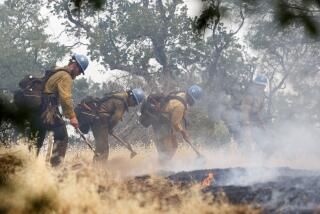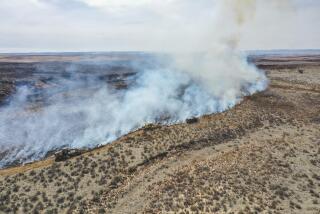Drought-fed wildfire burns at least 150 structures in Texas Panhandle
- Share via
Houston — At least 156 structures were destroyed in the Texas Panhandle and 2,100 residents were evacuated after a wildfire burned up to two square miles northeast of Amarillo, fire officials said Monday.
One person died of a heart attack during the blaze, but it was unrelated to the fire that started in the small town of Fritch late Sunday afternoon, said Phillip Truitt, a spokesman for the Texas A&M Forest Service.
The fire, which burned through the Lake Meredith Harbor subdivision, was about 35% contained Monday. It was whipped up by seasonal winds and fed by dry, parched brush due to an ongoing drought, said Hutchinson County Deputy Fire Chief Jason Wright.
About 300 firefighters were still working in the area Monday, assessing hot spots and damage, Wright said.
Texas Department of Public Safety Trooper Christopher Ray said there were “fire trucks as far as the eye can see.”
Firefighters faced numerous challenges in containing the blaze in the northwestern Texas canyons, he said.
“The wind is stirring up the smoke and dust so we’ve got some visibility problems,” Ray said, and, “You can’t go down a ravine or crevice — you have to wait for the fire to come to you.”
It’s not clear what caused the blaze. But the Panhandle has been in a state of exceptional drought for years, and this spring has been marked by winds gusting up to 50 mph and the humidity below 10%.
“This time last year we had four inches of rain. This year we’ve only had about an inch,” Ray said.
Weather conditions turned favorable for firefighters, though — a cold front arrived overnight Sunday, temperatures dropped 30 degrees into the 60s and humidity stabilized at 28%.
Firefighters have been able to extract plenty of water to fight the fire from a local lake and well.
“Tomorrow they’re hoping for some drizzle to come in,” Ray said.
The last major fire to sweep through the area three years ago in February did not burn any structures. A deadly fire in 2006 killed a dozen people and burned structures.
The fire risk is likely to continue and has prompted burn bans in the area because of the long-term drought, according to Joe Harris, a meteorologist with the National Weather Service in Fort Worth
“That place has been bone dry for some time,” he said. “What little rainfall they did get early in the spring did produce some grasses, but when those grasses seed out, they die back. So you’ve got a lot of dry vegetation. It’s ready to burn. Once the wind picks up and you get it moving pretty fast, if you get a fire, it’s going to move rapidly.”
Although the new cold front could bring rain, he said, all of western Oklahoma to the north, Big Bend National Park to the south, Kansas and New Mexico to the west and Texas Hill Country to the east will remain dry, especially the Panhandles of Oklahoma and Texas, through summer.
More to Read
Sign up for Essential California
The most important California stories and recommendations in your inbox every morning.
You may occasionally receive promotional content from the Los Angeles Times.











